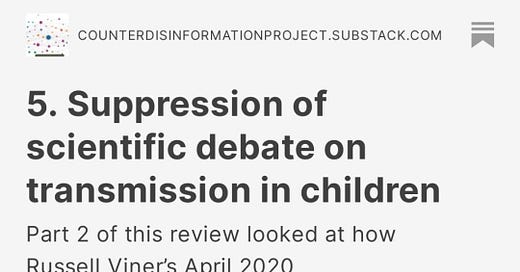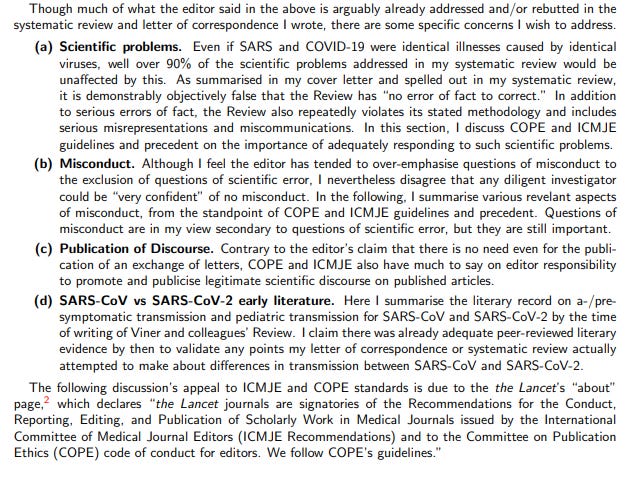5. Suppression of scientific debate on transmission in children
Part 2 of this review looked at how Russell Viner’s April 2020 systematic review became one of the key papers in 2020 that claimed children and schools didn’t play a significant role in the transmission of covid.
Part 5 of this review covers what happened to the official complaint made to the Lancet Child & Adolescent Health journal regarding its publication of Viner’s systematic review.
Although the complaint made by the mathematician Dr Rasmussen of Cambridge University was a detailed academic response, the Chief Editor Jane Godsland chose not to have the response processed by peer review. Instead Godsland spoke to Viner and decided that his explanations were enough to dismiss criticism of the systematic review.
This is one of many examples of how criticism of studies by key advisers to the government on covid in children have been dealt with, be it studies in journals or statistics covered by the regulator. They would not even publish the criticism.
Dr Rasmussen’s response to the summary dismissal of her request for an audit is provided in full. This had little impact and Viner’s systematic review continued to be widely cited as evidence against measures to reduce transmission and against offering vaccination to under 18s.
Response to Viner/Godsland’s excuses for dismissing audit
Sarah D Rasmussen, PhD - Centre for Mathematical Sciences, Wilberforce Road, Cambridge CB3 0WB,
Godsland said there because there was “insufficient evidence that asymptomatic children are significant transmitters” there was “no error or fact to correct, nor a discussion of sufficient merit to justify the publication of (Rasmussen’s) letter.
Rasmussen highlights that the review contains “serious errors” and “violates its stated methodology”, and that the guidelines for publications like the Lancet Child & Adolescent Health expect a more robust response to such scientific problems.
Scientific problems: the review “uses inappropriate methodology both in the sense of repeatedly blatantly violating its meticulously-stated search and exclusion criteria” and “also arguably questionable methodology for the Review to attempt to extrapolate the impact of school-closures on SARS-CoV-2 spread from the impact of school-closures on SARS-CoV spread, given the known extreme differences in a-/pre-symptomatic transmission of these viruses, as discussed in section”
Misconduct: “I not only believe that Viner and colleagues’ Review suppresses key data” … “that it…”
misrepresents the content and topics of various papers
makes deceptive/misleading statements
falsifies data/findings from at least one paper
misrepresents its own results in its summary
I also believe there is evidence that in each of these categories, there is at least one fault—if not more—that has strong indications of having been intentional, in which case it would constitute misconduct.
Publication of discourse: Rasmussen sets out how influential the paper had been in the past two months, likely the most influential the journal had ever published and questions why the journal appeared to be suppressing debate on the paper.
“The journal was apparently uninterested, however, in allowing “a range of opinions to be expressed,” since despite (by their own account) receiving so much correspondence on this Review that it took them 11 days to reply to my email, they did not publish a single letter of correspondence about this Review.”
“Godsland actually claimed that COPE guidelines prevented her from sending my letter of correspondence out for peer review, despite having previously encouraged me to formally submit a letter of correspondence, albeit warning me that my letter would be peer reviewed”
“Surely if journals are asked to advertise the fact that articles are under investigation, they are not expected to suppress scientific debate in the meantime.”
The final section of Rasmussen’s response raises the validity of using data on the transmission of SARS to predict SARS2 particularly considering differences in asymptomatic transmission. Its also noted that due to the incredible speed of covid’s spread across the planet there were already more than ten times as many cases of SARS2 to study than there were for SARS by June 2020.
A selection of recent studies on covid were provided as examples.
“This is not how science is supposed to work.”
Summary
Dr Rasmussen’s raised many valid criticisms of Viner’s systematic review, and she was far from alone in making these complaints, and yet her efforts were dismissed after a discussion between the editor and Viner. This has been cited as an example of the gate keeping that has protected those responsible for the government’s relaxed attitude to infections in children where they have often been allowed to mark their own homework.
There certainly appears to be a sense of deference within public health towards those in senior positions where other experts working with government authorities choose not to directly challenge even the most questionable comments by their senior colleagues. This was certainly the case in regards to outlier decisions such as initially choosing not to offer vaccination for children and then to withdraw vaccination while other countries like the US are adding covid to the standard list of recommended immunisations. There are also the cases of hepatitis in children where covid was dismissed as a possible cause to investigate despite papers from Italy and India having already drawn this link the year before.












